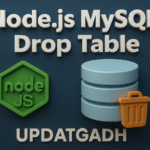
Python OOPs Concepts: A Complete Guide
Python OOPs Concepts
Python, like other general-purpose programming languages, is inherently object-oriented. From its inception, Python has enabled developers to use an object-oriented paradigm to design applications using classes and objects. This approach is widely recognized for its ability to produce reusable and maintainable code, making it a preferred choice in software development.
In object-oriented programming (OOP), we model the program using real-world entities, such as a book, car, or house. These entities are represented as objects, and the relationships between them are defined using classes. The primary principles of OOP enable developers to design programs that are scalable, efficient, and easy to understand.

Let’s dive into Python’s core OOP principles:
Download New Real Time Projects :-Click here
Core Principles of Python’s Object-Oriented Programming
1. Class
A class is a blueprint for creating objects. It contains the object’s data as well as the methods for working with it. A class does not consume memory on its own; memory is allocated when an object is created from the class.
Example:
class Employee:
def __init__(self, name, age, salary):
self.name = name
self.age = age
self.salary = salary
def show_details(self):
print(f"Name: {self.name}, Age: {self.age}, Salary: {self.salary}")2. Object
Objects are instances of a class. A class creates an object and allots memory for its data members when it is instantiated. Objects represent real-world entities with states and behaviors.
Example:
emp1 = Employee("John", 28, 50000)
emp1.show_details()
# Output: Name: John, Age: 28, Salary: 500003. Method
Python methods are routines that work on class instances. They have the ability to view and change the object’s properties.
4. Inheritance
A class (child) can inherit the attributes and functions of a parent class through inheritance. This promotes reusability and a hierarchical structure.
Example:
class Vehicle:
def __init__(self, brand):
self.brand = brand
def show_brand(self):
print(f"Brand: {self.brand}")
class Car(Vehicle):
def __init__(self, brand, model):
super().__init__(brand)
self.model = model
def show_model(self):
print(f"Model: {self.model}")
car1 = Car("Toyota", "Corolla")
car1.show_brand()
car1.show_model()
# Output: Brand: Toyota
# Model: Corolla5. Polymorphism
A single interface can represent multiple types thanks to polymorphism. It permits objects of several classes to be regarded as belonging to the same superclass.
Example:
class Animal:
def speak(self):
pass
class Dog(Animal):
def speak(self):
print("Woof!")
class Cat(Animal):
def speak(self):
print("Meow!")
animals = [Dog(), Cat()]
for animal in animals:
animal.speak()
# Output: Woof!
# Meow!6. Encapsulation
Encapsulation binds data (attributes) and methods (functions) together and restricts direct access to them, protecting the object’s integrity. A double underscore prefix (__) can be used to make attributes secret.
Example:
class BankAccount:
def __init__(self, balance):
self.__balance = balance
def deposit(self, amount):
self.__balance += amount
def get_balance(self):
return self.__balance
account = BankAccount(1000)
account.deposit(500)
print(account.get_balance())
# Output: 15007. Abstraction
Only the key characteristics are shown by abstraction, which conceals the implementation specifics. Abstract classes and interfaces are used to achieve this in more complex applications.
Object-Oriented vs Procedural Programming
| Feature | Object-Oriented Programming | Procedural Programming |
|---|---|---|
| Approach | Problem-solving using objects and classes | Step-by-step instructions |
| Real-world Simulation | Simulates real-world entities | Does not simulate real-world concepts |
| Reusability | High reusability due to inheritance | Less reusable |
| Security | Provides data hiding using encapsulation | Limited security |
| Examples | Python, Java, C++ | C, Fortran, Pascal |
Benefits of Python OOP
-
- Code Reusability: Inheritance and polymorphism allow developers to reuse code across different modules.
-
- Scalability: The modular structure makes scaling up applications easier.
-
- Real-world Modeling: Classes and objects closely represent real-world scenarios, simplifying the design process.
-
- Ease of Maintenance: Encapsulation ensures that changes to a class do not affect its users, making maintenance seamless.
| Finding the Second Largest Number in Python |
https://updategadh.com/python/finding-the-second-largest-number/ |
| Python SimpleImputer Module: A Comprehensive Guide |
https://updategadh.com/python/python-simpleimputer-module/ |
| Python OpenCV Object Detection: A Step-by-Step Guide |
https://updategadh.com/python/python-opencv-object-detection/ |
| Python Program for n-th Fibonacci number |
https://updategadh.com/python/python-program-for-n-th-fibonacci/ |
| Exploring the nsetools Library in Python: A Guide to Real-Time Stock Data |
https://updategadh.com/python/nsetools-library-in-python/ |
- PHP PROJECT:- CLICK HERE
- INTERVIEW QUESTION:-CLICK HERE
- Complete Advance AI topics:- CLICK HERE
- Complete Python Course with Advance topics:- CLICK HERE
python oops concepts w3schools
oops concepts in python with examples
python oops interview questions
oops concepts in python with examples pdf
polymorphism in python
python oop cheat sheet
object-oriented programming python book
oops concepts in java
python compiler
python interview questions
python oops concepts
python oops concepts pdf
python oops concepts w3schools
python oops concepts interview questions
python oops concepts cheat sheet
python oops concepts javatpoint
python oops concepts questions
python oops concepts ppt
python oops concepts advanced
python oops all concepts
oops concepts in python and java










Post Comment